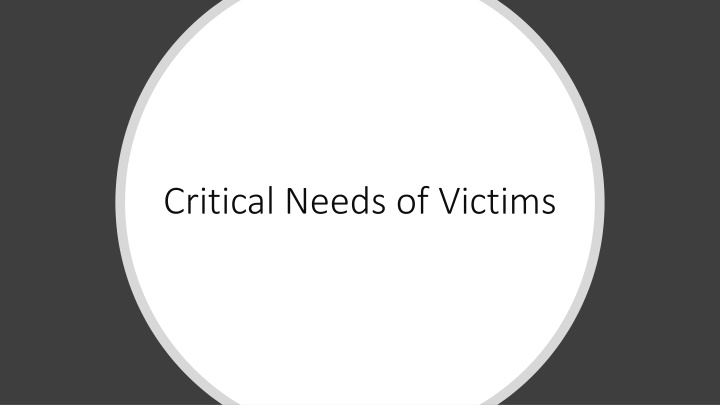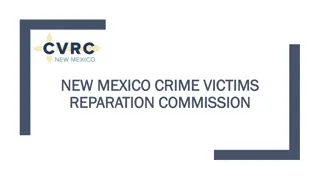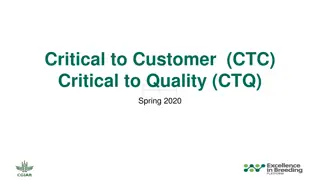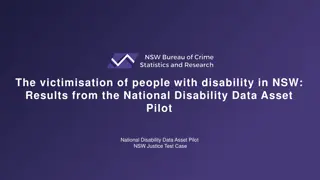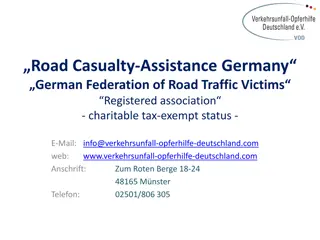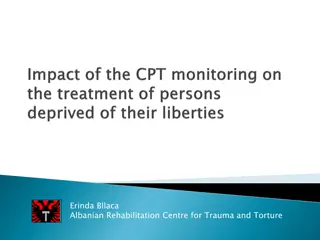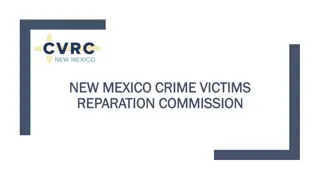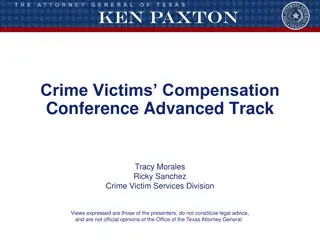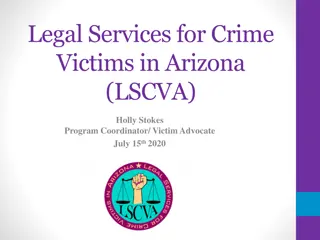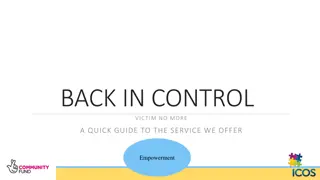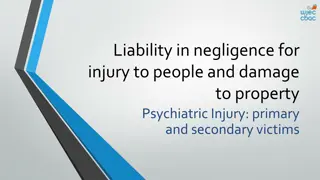Meeting Critical Needs of Victims: Partnerships and Expectations
Meeting the critical needs of victims involves ensuring safety, support, access, continuity, voice, and justice. This requires collaboration with various professionals and effective communication among all stakeholders involved in the criminal justice system. Understanding and meeting the expectations of partners and victims is essential for providing comprehensive assistance and support to victims of crime.
Download Presentation

Please find below an Image/Link to download the presentation.
The content on the website is provided AS IS for your information and personal use only. It may not be sold, licensed, or shared on other websites without obtaining consent from the author.If you encounter any issues during the download, it is possible that the publisher has removed the file from their server.
You are allowed to download the files provided on this website for personal or commercial use, subject to the condition that they are used lawfully. All files are the property of their respective owners.
The content on the website is provided AS IS for your information and personal use only. It may not be sold, licensed, or shared on other websites without obtaining consent from the author.
E N D
Presentation Transcript
Critical Needs of Victims Safety Support Information Information about risk reduction and likelihood of revictimization Help navigating criminal justice system processes Concise and useful information about criminal justice system processes Information about processes and services aimed at increasing safety Connection to victim services personnel Information about rights and available resources Information about physical, emotional, and psychological safety Availability of support persons chosen by victims Future points of contact and status updates (e.g., investigation, prosecution)
Critical Needs of Victims Access Continuity Voice Justice/Resolution Opportunities to participate in criminal justice system processes Collaboration with other professionals to ease transitions for victims Encouragement to ask questions and have their concerns heard Ensure skills, training, experience to complete offender-focused investigations Information available in languages spoken/ understood by victims Clear understanding of everyone s roles Invitation to participate in case-related and agency practice discussions Hold offenders accountable Information sharing and promotion of research- informed practices Attention to special needs and access barriers Ask victims for input and views on case resolution not all victims define justice the same way!
Partners and Expectations Meeting the critical needs of victims requires solid partnerships and collaboration. Use your partners professionally and effectively. What are your expectations of others? Are they accurate? Officers, investigators, prosecutors, SANEs, victim services personnel (agency employed and community based), community agencies, criminal justice professionals, and others Victims What are others expectations of you? Are they accurate? Officers, investigators, prosecutors, SANEs, victim services personnel (agency employed and community based), community agencies, criminal justice professionals, and others Victims Communicate regularly with all partners and victims.
Expectations of Victim Services Personnel Provide an interface between the victim and the criminal justice system Explain concepts, language, options, and possible outcomes Assist with reactions without compromising essential relationships Support victim self-determination when possible Support victims choices above desires of system professionals Inform victims of choices in their control and those made by others (e.g., investigators, prosecutors) Educate victims about their rights How to exercise rights Case resolution options
Expectations of Victim Services Personnel Initial and ongoing assessment Victim presentation, needs, and desires may change over time Exchange information with key partners Safety planning at every meeting Address current emotional and physical safety of self and others Discuss future safety plans Focus on victim well-being and healing process Explain criminal justice processes Discuss community services
Critical Needs During Investigation
Critical Needs of Victims Critical Needs of Victims Safety Support Information Access Continuity Voice Justice
Possible Investigative Actions Victims rights review rights and how to exercise them Victim interview Logistics of interview (when, where, types of questions, permission to take breaks, presence of victim services personnel/support persons before/during/after) Permission for victim to ask questions, say I don t know, be unsure Prepare victims for difficult questions Bridge gaps in comfort levels around sensitive topics both with professionals and with victims Assist with language and other access needs Witness interviews and interviews of prior partners of the suspect Discuss safety concerns Warn of consequences from witness contact
Possible Investigative Actions Forensic exams Logistics of process (when, where, associated costs, victim services personnel presence before/during/after) Assist in addressing ongoing/resulting health concerns (pregnancy, STI, substance use) Suspect interview Complete safety planning with victim related to suspect interview and post- interview contact Controlled communication Logistics of controlled communications (determine willingness/ability of victim to participate, script preparation, role plays, emotional responses, victim services personnel/support persons presence before/during/after)
Possible Investigative Actions Search warrants Explain process and length of time for expected outcomes Review safety concerns and consequences from search warrant execution that may impact victims Status updates Provide an avenue for ongoing case-related communication and updates Provide updates to law enforcement encourage law enforcement to anticipate different responses over time and time delays for decisions by victims Arrest warrants Safety planning and case management after an arrest Documentation and access to records Explain records access parameters and processes (who has access, how to request records, etc.) Discuss safety concerns and consequences from records access
Critical Needs After Investigation
Critical Needs of Victims Critical Needs of Victims Safety Support Information Access Continuity Voice Justice
Post-Investigative Processes Victims rights review rights and how to exercise them Prosecution Decisions Will the case be prosecuted? Who tells the victim about prosecution decisions? Is victim input considered? How? Victim Impact Statements Trial Preparation and Participation Logistics, purpose, and safety planning for all court dates Assist with language and other access needs Victim participation that is required vs. optional Presence of victim services personnel/support person before, during, and after trial
Post-Investigative Processes Potential Trial Outcomes Prepare victim for all possible outcomes Safety planning and resource connection for all possible outcomes Post-Sentence Processes Victims rights review rights and how to exercise them Logistics, purpose, and safety planning for all parole hearings/processes Participation options for all hearings/processes (victim/offender dialogue, execution viewing) Registration for custody status updates (transfers, releases, death, and escape)
Procedural Justice Are victims being treated with dignity and respect during all encounters? Are victims included in all process decisions? Is there transparency in all process decisions? Do system professionals have the necessary skills and training to foster trust in the system? Personal or professional judgements or desired outcomes are not to be substituted for those of the victims. Procedural justice can be extremely powerful for victims.
Questions Questions
